Single Courses
Single Courses

Center of entrepreneurship provides entrepreneurs and executives with Courses in Business Administration and Skills, which make them qualified to manage and lead their business and work teams to success.
Why choose Center of entrepreneurship ?
- The best specialized Consult for you.
- The best professors in the middle east.
- Professional academic support team.
- The best accreditation.
- The best quality.
- Competitive advantage for pricing system.
Why Study With Center of entrepreneurship ?
- Center of entrepreneurship using the best learning technology.
- Specialized technical team.
- Smart boards.
- Save more money.
- Save more time.
- Live inside the lecture hall.
- Save more efforts.
Financial Management

12500 L.E
Financial management can be defined as the activities involving planning, raising, controlling, and administering money that is used in the business. Financial management involves procuring funds for buying fixed assets, raw materials, and working capital.
diagnostic skills associated with the preparation and explanation of financial reporting; assessment skills associated with the use of financial information in decision-making; In order to achieve these aims it is necessary for you to have a strong understanding of the accounting systems that produce accounting and financial data. Therefore, you will also be required to develop: technical and computational skills associated with the production of accounting information
1- explain the objectives, concepts, and relationships that underpin both internal and external financial reports
2-research the financial performance and position of reporting entities
3-apply analytical tools, techniques, and frameworks to evaluate and critically examine the contents of both internal and external financial reports
4-communicate financial information to interested stakeholders in an ethical and professional manner
Human Capital Management

12500 L.E
This subject helps participants understand the concept and knowledge of managing human resources and its application in organizations. Areas of focus include an overview of the human resource environment and challenges faced by the organization, managing workflows and job analysis, the legal aspect of HR in Malaysia, human resource planning and recruitment, selection and testing process, training and development, managing organizational renewal, appraising and improving performance, managing compensation and incentives, occupational safety and health at the workplace and employee relations.
1-Define, elaborate, and discuss relevant concepts related to the theoretical and practical Human
Resource Management issues facing business organizations.
2-Apply appropriate techniques to solve specific real-life HR issues.
3-Demonstrate their knowledge and understanding of the subject matter through group discussions
and written assignments, make a clear conclusion, and deliver appropriate decisions for a decision situation.
- Overview of the HR Environment and the Challenges Faced by Organization
- Understanding the Role of HR and Its Importance
- HR Strategies to Improve Firm’s Performance
- Managing Work Flows and Job Analysis
- Structuring and Designing Organization
- Designing Jobs and Conducting Job Analysis
- KRIS
- Legal Aspects of Human Resource
- Understanding the Legal Environment
- EEOQ and Fair Employment Practices
- Human Resource Planning Recruitment and Selection
- Techniques of HR Planning
- Forecasting Demand and Supply
- Recruiting Job Candidates
- Training and Development of Employees
- Why Training & Education is important?
- Training Process & Techniques
- Evaluating Training Investment
- Training and Development of Employees
- Why Training & Education is important?
- Training Process & Techniques
- Evaluating Training Investment
- Appraising and Improving Performance
- Process and Methods of Appraising
- Problems in Appraising
- Managing Compensation and Incentives
- Basic Factors in Determining Pay Rates
- Types of Compensation & Benefits
- Managing Safety and Health at the Workplace
- Establishing OSHA Programs
- Creating a Healthy Work Environment
- Employee Rights and Discipline
- Developing Employee Communications
- Administering and Managing Discipline
Leading Organization

12500 L.E
This module offers an opportunity for senior-level managers to acquire export insights,
explore leadership and people management concepts and examine actionable strategies for building the kind of leadership and people management to enable employees to deliver their optimum performance,
this module also aims to provide students with ideas,
frameworks and tools required increasing an environment and culture in which individuals feel compelled to innovate and contribute to a transforming work environment.
- Incorporate the characteristics of good leadership into corporate projects and routine work.
- Explain why different types of leadership styles impact a company’s culture.
- Map out the qualities, characteristics, and behaviors of an effective leader and choose one that will work with a particular organization’s leadership style.
- Demonstrate their knowledge and understanding of the subject matter through group discussions and written assignments.
- -Definition and Significance of Leadership
- Definition of Leadership
- Key Elements of Leadership
- Why Do We Need Leaders?
- Obstacles to Effective Leadership
- Leadership and Management
-The Global and Cultural Contexts
- Learning Objectives
- Defining Elements of Culture
- Hall’s Cultural Context
- Individualism—Collectivism
- GLOBE Country Clusters
- GLOBE Cultural Leadership Profiles
- Suggested Causes for Gender Inequality in Organizations
-The Foundations of Modern Leadership
- Eras of Modern Leadership
- The Trait Era—Assumptions and Findings
- The Behavior Era—Assumptions and Findings
- Fiedler’s Contingency Model
- Task and Relationship—Motivated Leaders
- Fiedler’s Contingency Mode
- Practical Implications of Fiedler’s Contingency Model
- Contingency Factors in the Normative Decision Model
- Path-Goal Theory
-Individual Differences and Traits
- Individual Differences Framework
- Demographic Characteristics
- Abilities and Skills
- Skills and Career Progression
- How Traits Play a Role in Leadership
- Proactive Personality
- The Dark Triad
-Power
- DefinitionsImpact of Power on Power Holder
- Culture and Power
- Potential Reactions to Individual Sources of Power
- Career Stages and Power
-Current Era in Leadership: Inspiration and Connection to Followers
- Benefits of the New Era Approaches
- Requirements of Charismatic Leadership
- Elements of the Charismatic Situations: External Factors
-Leading Teams
- Continuum of Participation
- Benefits of Participation
- Benefits of Delegation
- Elements of Self-Leadership
- Structural Factors in Building Effective Teams
- Role of Team Leaders
-Developing Leaders
- Definitions
- Types of Development
- Factors in Learning
Managerial Accounting

12500 L.E
This course enables students to understand the main functions and roles of management accounting in an organization. In addition to that, students can distinguish costs in accounting and are able to prepare financial and operating budgets. The relevance of knowledge management cost accounting is that it assists candidates to making accurate decision-making in the organization
1-Define, describe and discuss topics covered and identify their relevance in practice and how they relate to and impact organisations in doing business activities.
2-Apply appropriate techniques to solve specific real life business legal issues.
3-Demonstrate their knowledge and understanding of the subject matter though group discussions and written assignments, make clear conclusion and deliver appropriate decisions for a decision situation.
- Introduction To Management Cost And Accounting
- Development of Cost and Management Accounting
- Difference Between Management and Financial Accounting
- Management Accounting Role in Performance Evaluation and Rewards
- Cost Concepts And Cost Classification
- Manufacturing Costs
- Material Costs, Labour Costs, and Overhead
- Opportunity Costs and Sunk Costs
- Costing Systems
- Cost Accounting Systems
- Job Order Costing
- Process Costing
- Activity-based Costing
- Cost-Volume-Profit Analysis
- Cost-Volume Relationship
- Cost Behavior and Operating Income
- Contribution Margin, Margin of Safety
- Special Decisions
- Concept of Relevant Cost Information
- Opportunity Costs, Sunk Cost
- Incremental Analysis in Common Business Analysis
- Special Order Decision, Production
- Constraint Decisions
- Operational Budgeting
- Budgeting; Basis for Planning and Control
- Establishing Budgeted Amounts
- Budget Period
- Master Budget
- Standard Costing and Budgetary control
- Concepts – standard costs and standard setting
- Variance Analysis
- Capital Budgeting
- Significance of Decision Rule
- NPV and IRR Methods
- Capital Rationing and Risk
- Frontiers of Management Accounting
- TQM and Cost of Quality
- Benchmarking
- Advanced Manufacturing Technology
Project Management

12500 L.E
Project Quality Management includes the processes for incorporating the organization’s quality policy regarding planning, managing, and controlling the project and product quality requirements in order to meet stakeholders’ objectives.
Project Quality Management also supports continuous process improvement activities as undertaken on behalf of the performing organization.
The main objective in project quality management is making sure that the project meets the needs it was originally created to meet—nothing more, nothing less. In other words, to ensure quality, you must meet the needs of the stakeholder.
1-Quality’s Foundations
A. Defining Quality
B. Project Quality and Project Scope
C. Quality Management’s Evolution
D. Characteristics, Concepts, and Founders of the Modern Quality Movement
2-Quality Planning for Customer Satisfaction
A. Customer Expectations, Standards, and Requirements
B. Writing Quality-Supportive Requirements
C. Building a Standards-Requirements Matrix
3-Quality Assurance Tools
A. Quality Assurance versus Quality Control
B. Designing a Quality Audit
4-Quality Control Concepts and Tools
A. Quality Statistics 101
B. The Seven Basic Tools of Quality
C. Selecting the Right Quality Control Tool for the Right Project
D. Defining Metrics
5-Putting it All Together: Building a Quality Management Plan
A. Tracing Scope, Quality, and Customer Expectations Together
Managing Operation

12500 L.E
The course introduces the basic concepts of operation management to the students.
More specifically, the students are to understand the important role played by the production/operation function in a business and its relation to the other functional areas.
The students will also learn on how to analyze operations decision situations using the relevant techniques.
1-Define, elaborate and discuss relevant concepts related to the theoretical and practical Operation Management issues facing business organizations.
2-Apply appropriate techniques to solve specific real life OM issues.
3-Demonstrate their knowledge and understanding of the subject matter though group discussions and written assignments, make clear conclusion and deliver appropriate decisions for a decision
situation.
- Time Series methods
- Forecast accuracy
- Regression methods
- Design of Goods and Services
- Goods and services selection
- Product development
- Issues with product design
- Time-Based competition
- Defining product
- Application of decision trees to product design
- Aggregate Planning
- Capacity planning
- Aggregate planning
- Adjusting capacity to meet demand
- Demand management
- Inventory Management
- Elements of inventory management
- Inventory control system
- Economic order quantity models
- Just In Time (JIT)
- Basic elements of JIT
- Benefits of JIT
- JIT implementation
- Material Requirements Planning (MRP)
- Introduction to MRP
- MRP structure and management
- Lot size techniques
- Quality Management
- The meaning of quality
- Total Quality Management (TQM)
- Strategic implications of TQM
- The cost of quality
- Process Strategy
- Four process strategies
- Process analysis and design
- Service process design
- Production technology
- Technology in services
- Location Strategy
- The strategic importance of location
- Factors affecting location decisions
- Methods of evaluating location alternatives
- Service location strategy
Marketing Management

12500 L.E
- This course is designed to take graduates from any discipline into careers in marketing management.
- We don’t just teach the theory of marketing. There’s a lot of emphasis on applying what you learn in a business setting.
- You can also apply to do a company-based dissertation, working with an external organization. Recent dissertation projects include a branding review for a large law firm and working with a local, environment-led SME to study consumer behavior.
This course addresses how to design and implement the best combination of marketing
efforts to carry out a firm’s strategy in its target markets. Specifically, this course seeks to
develop the student’s
(1) understanding of how the firm can benefit by creating and
delivering value to its customers, and stakeholders, and
(2) skills in applying the analytical
concepts and tools of marketing to such decisions as segmentation and targeting, branding,
pricing, distribution, and promotion. The course uses lectures and case discussions, case
write-ups, student presentations, and a comprehensive final examination to achieve these
objectives.
Course Objectives:
1. To familiarize you with the basic concepts and techniques of marketing management.
2. To understand the behavior of consumers
3. To create awareness of marketing mix elements.
4. To analyze and solve marketing problems in the complex and fast-changing business
environment.
1-Marketing Concepts and Creating Value
2 – Strategic Marketing
3 – The Marketing Environment
4 – Marketing Research
5 – Consumer Behaviour
6 – Brand Branding, Brand Equity, and Brand Positioning
8 – Dealing with Competition
9 – Product and Services Strategy
10 – Pricing Strategy
11 – Distribution Strategy
Supply Chain
Course

12500 L.E
Understand the concepts of Supply Chain Management, get an update on SCM principles in general and on the SCM supply chains in specific, transfer knowledge gained to the own work situation, and exchange experience with peers The increasing strategic role of supply chains and its global challenge to compete not just with innovative products but with efficient and effective supply chain management requires skilled and highly competent players across the whole value chain.
- Introduction to Supply Chain Management.
- Provide a review of SCM supply chain management from planning and control
- Demand Management, forecasting techniques.
- Sales & Operations Planning S&OP – Master Scheduling MPS
- Materials Requirement Planning MRP
- Capacity Planning and Control
- Inventory Management and IC Inventory Control.
- ABC Classification & Cycle Count inventory auditing technique
- Procurement & Purchasing ManagementLean & Quality system – Theory of Constraints
- Introduction
- Operations and Supply Chain Management
- Elements of OSCM
- Why it is important to study OSCM
- Efficiency: Impact of reducing the Inventory cost
- Measures for Efficiency
- A comparison of Automobile Companies’ efficiency
Managing Business Strategy


